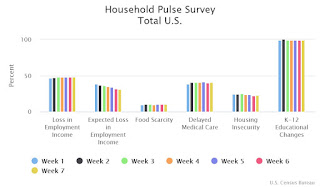From the Census Bureau: Measuring Household Experiences during the Coronavirus (COVID-19) Pandemic
The U.S. Census Bureau, in collaboration with five federal agencies, is in a unique position to produce data on the social and economic effects of COVID-19 on American households. The Household Pulse Survey is designed to deploy quickly and efficiently, collecting data to measure household experiences during the Coronavirus (COVID-19) pandemic. Data will be disseminated in near real-time to inform federal and state response and recovery planning.
…
Data collection for the Household Pulse Survey began on April 23, 2020. The Census Bureau will collect data for 90 days, and release data on a weekly basis.
This will be updated weekly, and the Census Bureau released the recent survey results today. This survey asks about Loss in Employment Income, Expected Loss in Employment Income, Food Scarcity, Delayed Medical Care, Housing Insecurity and K-12 Educational Changes.
 Click on graph for larger image.
Click on graph for larger image.
The data was collected between June 11 and June 16, 2020.
Definitions:
Loss in employment income: “Percentage of adults in households where someone had a loss in employment income since March 13, 2020.”
This number is since March 13, and hasn’t changed significantly.
Expected Loss in Employment Income: “Percentage of adults who expect someone in their household to have a loss in employment income in the next 4 weeks.”
31% of households expect a loss in income over the next 4 weeks. This is down from 38.8% in late April.
Food Scarcity: Percentage of adults in households where there was either sometimes or often not enough to eat in the last 7 days.
About 10% of households report food scarcity.
Delayed Medical Care: “Percentage of adults who delayed getting medical care because of the COVID-19 pandemic in the last 4 weeks.”
41% of households report they delayed medical care over the last 4 weeks. This has not declined.
Housing Insecurity: “Percentage of adults who missed last month’s rent or mortgage payment, or who have slight or no confidence that their household can pay next month’s rent or mortgage on time.”
23.2% of households reported they missed last month’s rent or mortgage payment.
K-12 Educational Changes: “Percentage of adults in households with children in public or private school, where classes were taught in a distance learning format, or changed in some other way.”
Essentially all households with children are reporting were not being taught in a normal format.